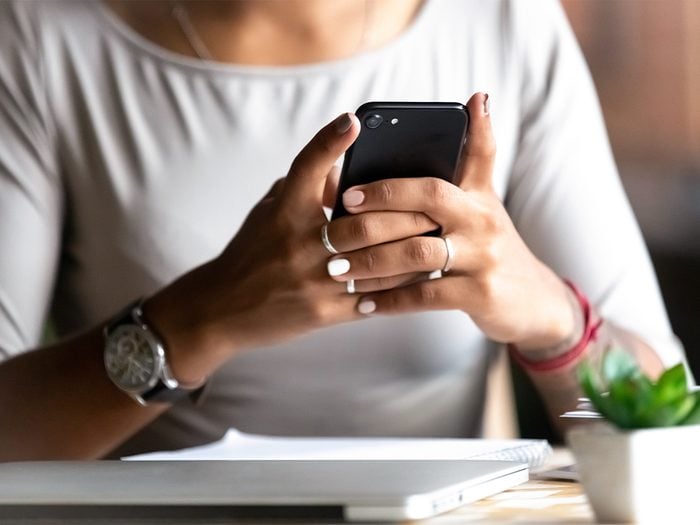Your Phone Might Be Hurting Your Hand

Texting thumb? Hand pain? Experts are seeing a rise of injuries linked to our obsession with our phones.
Canadians use their smartphones for just about everything, from online shopping to working to staying connected. According to a report by analytics company App Annie, Canadians spent an average of 4.4 hours a day on mobile apps in 2021—up from 3.9 hours a day the previous year. A 2020 StatsCan survey further noted that 84 percent of Canadians rely on a smartphone for communication, research and entertainment. It’s a device that, for many of us, is always within reach if not in use.
While it’s clear that smartphones are an integral part of daily life, reliance on our mobile devices might also be leading to hand, wrist and arm pain. A 2015 study published in the Journal of Physical Therapy Science found there is a clear link between smartphone use and general musculoskeletal pain and injuries, with about 27 percent of those studied feeling pain in their wrists, 19 percent feeling pain in their arms and nearly 20 percent experiencing finger pain.
Jennifer Howey, the owner of Inside Out Physiotherapy in Toronto and a clinical lecturer at the University of Toronto, notes that many of her patients are coming in with repetitive strain injuries that are a result of being glued to their phones. “These are conditions we used to see in someone who is working their hands all day long, like a jeweler,” says Howey. “These aren’t conditions that used to be associated with the general population, but now they increasingly are.”
Here’s what experts want you need to know about common smartphone-related injuries, including how you can avoid the pain and when to see a professional.
What are repetitive strain injuries?
According to Howey, repetitive strain injuries occur when you continually repeat a motion with little to no break, so the muscles and tendons in use don’t get to rest. Before smartphones, she says, these are the type of injuries that factory workers experienced often—they had one task that they repeated all day long.
Smartphone-related repetitive strain injuries are caused by the constant pressure being put on the thumb and index finger when we’re texting, swiping and scrolling. “The tendons can get inflamed,” says Howey. “When the inflammation starts to accumulate, the tendons get stuck—and tendons are meant to glide amongst each other.”
Repetitive strain injuries are common, according to Howey. Gautam Sadarangani, the co-founder and COO of Tenzr Health, a company that provides clinicians with personalized physical therapy technology, notes that more than 70 percent of patients using Tenzr have a repetitive strain-related diagnosis. The most common smartphone-related repetitive strain injury is called texting thumb.
What is texting thumb?
Texting thumb, a.k.a. smartphone thumb or trigger finger, occurs when there’s inflammation in the tendons in the fingers, says Howey. This condition is most common in the pointer finger and the thumb and is characterized by your finger being stuck in a curved position, like you’re about to pull a trigger.
Untreated, smartphone-related injuries like texting thumb can lead to weak hands and wrists and pain.
What can you to do to prevent texting thumb?
“It’s in the name—repetitive stress. So, reducing the total amount of use throughout the day is important,” says Sadarangani. Take time away from your phone, or rest it against something like a stand or even a pillow to reduce the time you’re gripping it.
If you need to type something long, switch to your computer. “On a keyboard, your hands are free to move around more,” says Howey. “On a phone, they’re working in a really confined space.” Or, instead of texting your friend the latest drama in your life, try sending a voice memo or hopping on a call to cut your fingers some slack.
Howey also suggests getting a stress ball and rolling your hands out with it to stretch out the tendons. Plus, you can squeeze it gently to promote blood circulation. Another great way to get those muscles worked through? Go for a manicure. “Get someone else to massage that arm,” says Howey, and opt for the warm wax treatment—warmth helps increase blood flow, relax muscles and decrease joint stiffness.
Finally, loosen your grip. “You don’t need to grip your phone as hard as you think you do,” says Howey. “We grip sometimes up to 30 percent more than we need to.” Add-ons like popsockets can also help your hand into a more relaxed position while holding the phone.
What if my hand hurts, but it’s not a repetitive strain injury?
The way we hold our phones—with most of our fingers supporting the back and our thumb on the touchscreen—puts stress on the ulnar nerve (which runs from the neck all the way down to the hand) and the median nerve (which runs from the armpit area through the forearm to the fingers). “A nerve is like an elastic band, and it doesn’t like to be held in one position,” says Howey. If you’ve strained those nerves, you’ll feel a tingle or pain when you release your hand or extend your arm, according to Howey.
Many of solutions for texting thumb will also work for nerve-related pain: stretch out your fingers with a ball, switch to a computer or keyboard and indulge in some heat therapy like an Epsom salt bath.
When should I see a professional?
As soon as possible, say both Howey and Sadarangani. “If the pain isn’t going away, if it’s starting to wake you up at night, if you’re having difficulty with other tasks, you want to get right in [to see a professional],” Howey says. “We can catch things early and teach preventative techniques and work with you to try to make it feel better.”




